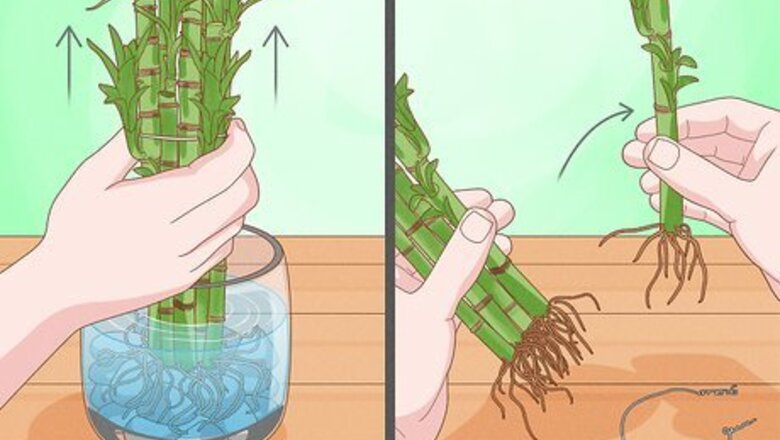
views
Taking a Cutting

Remove the lucky bamboo stalks from their container. Take the lucky bamboo from its container and remove any wire that’s holding the stalks together. Gently comb through the roots with your fingers to separate them, and then separate all the stalks. Pour the water from the container into a colander to drain the water and catch the pebbles. Lucky bamboo often comes with wire holding the stalks together, but the wire can damage the plant, so it’s best to remove it.
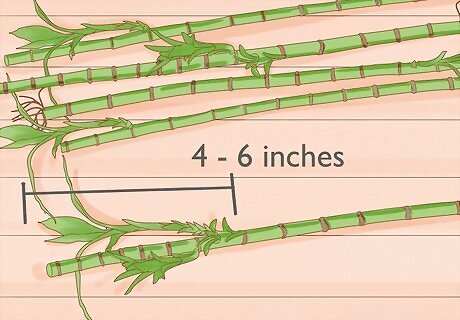
Choose a healthy stalk with a long offshoot. The parent stalk should have at least 2 nodes, which are the lines separating the lucky bamboo stalk into segments. Once you’ve identified the healthy, long stalks, look for a good offshoot. The offshoot should be 4 to 6 inches (10 to 15 cm) long, and should be dark green and growing from 1 of the upper nodes. Nodes are the areas on a plant from which leaves grow.
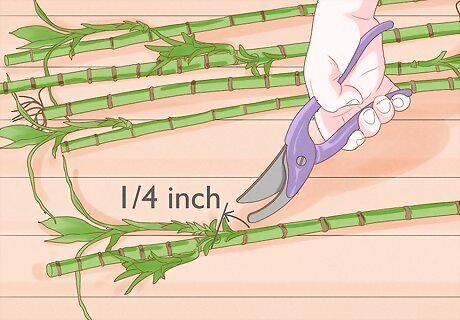
Trim off the offshoot. Use a sharp knife or pair of small pruning shears to carefully cut the offshoot from the parent stalk. Trim the offshoot as close to the stalk as possible. Then, use the shears or knife to trim off an additional ⁄4 inch (0.64 cm) from the bottom to make a straight cut.

Remove the bottom sets of leaves. Use your fingers to gently peel off the bottom sets of leaves from the cutting. Leave at least 1 set of leaves at the top intact. Removing the bottom leaves will redirect the plant’s energy to producing roots. It’s also important to remove the leaves so they don’t rot when you place the offshoot in water to root.
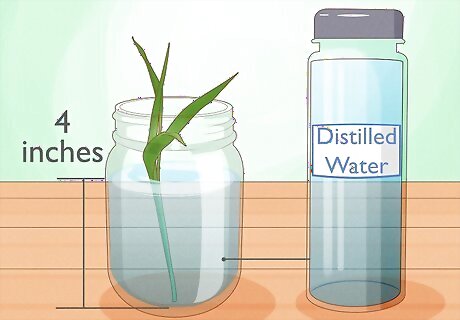
Place the cutting in a jar filled with distilled water. Fill a mason jar or other glass jar with 4 inches (10 cm) of distilled or bottled water. Put the cutting in the water with the cut end in the bottom of the glass. The cutting shouldn’t be completely submerged. If you have more than 1 cutting, you can put them all in the same jar. It’s important to use distilled or bottled water, because these don’t contain chlorine, which will damage the bamboo. If you want to use tap water, pour the water into the jar and let it sit for 24 hours to let the chlorine break down before putting in the cutting.
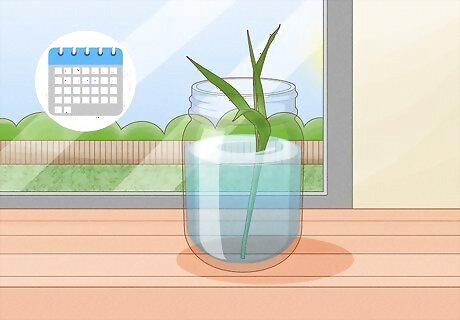
Place the cutting in indirect sunlight for a month. Transfer the cutting to a bright location that’s protected from direct sunlight. As the cutting sits in the water, it will begin to grow roots of its own. Eventually, you'll be able to plant or grow the cutting as its own plant. The rooting process will take about 30 days.
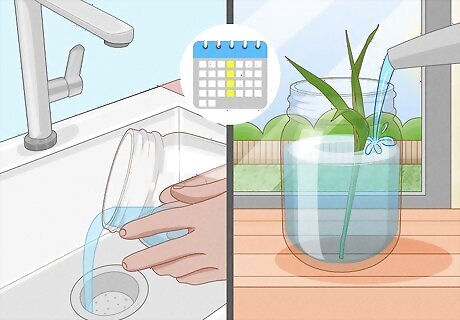
Replace the water weekly. Once a week, hold the lucky bamboo stalk in place and dump out the water from the jar. Replace the water with fresh distilled or bottled water. This will prevent the water from stagnating. As necessary, add more water to the jar to replace what’s evaporated or been absorbed by the growing plant.
Caring for the Cutting

Transfer the bamboo to a larger vase. When the lucky bamboo offshoot has had about a month to grow new roots, you can transfer it to its own vase. Fill the bottom of a jar or vase with at least 1 inch (2.5 cm) of pebbles, marbles, or gravel. Place the stalk into the jar, setting the bottom firmly in the pebbles to keep it upright. Fill the vase with about 4 inches (10 cm) of fresh, dechlorinated water. You can also plant the lucky bamboo in the vase with the other lucky bamboo that you took the cutting from.
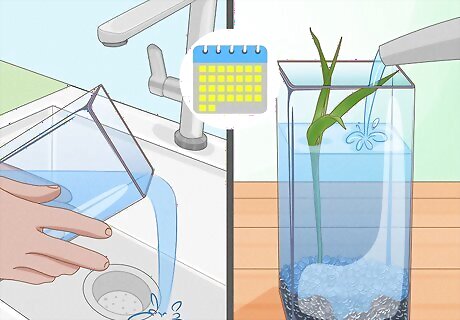
Change the water monthly. Lucky bamboo that’s grown in water needs a regular supply of fresh water. Every 30 days, drain the water in the vase and replace it with new water that’s been bottled, distilled, or left out to dechlorinate. If the water evaporates quickly throughout the month, top off the vase with fresh water.

Plant the lucky bamboo in soil as an alternative. Lucky bamboo also thrives in soil. Find a small pot that’s at least 3 inches (7.6 cm) deep, and that has good drainage holes. Fill the pot with a well-draining potting mix, such as cactus potting soil. Press the bottom of the lucky bamboo stalk 2 inches (5.1 cm) into the soil. Water the soil, and keep the soil slightly moist at all times. Use bottled, distilled, or otherwise dechlorinated water to water the bamboo. Fertilize the soil with a lucky bamboo fertilizer or diluted liquid house plant fertilizer to help the bamboo grow.
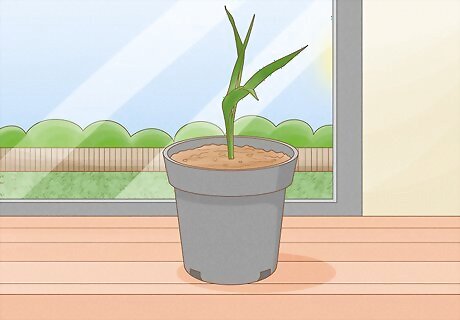
Place the bamboo in bright, indirect light. Bamboo needs lots of bright light to thrive, but it will burn quickly in direct sun. Find a bright location for the bamboo, such as a partially shaded windowsill, where it will get lots of light every day.
Caring for the Parent Stalk
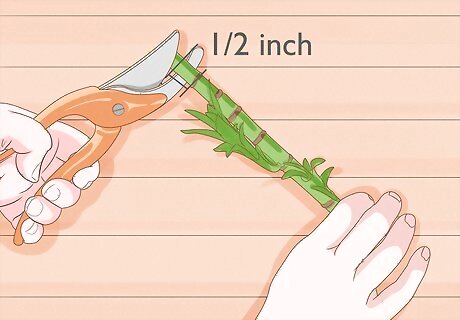
Trim off the top above the next node. Take the stalk from which you took the cutting and place it on a cutting board. Locate the node from which you cut the offshoot, and then find the next node down. Measure ⁄2 inch (1.3 cm) above that node, and then use a sharp knife or shears to trim off the top of the lucky bamboo stalk. Cutting the stalk just above the node will encourage new offshoots to grow.
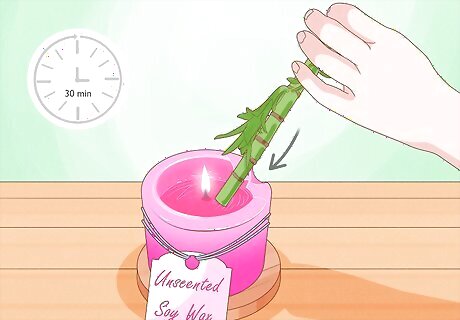
Dip the cut tip in white, unscented soy wax. Light a candle and allow it to burn for about 30 minutes. This will give the wax time to become liquid. When there's a small pool of liquid wax, dip the top of the trimmed stalk into the wax to seal the cutting. This will protect the wound from infections. The best type of wax for this is unscented white soy wax. Dyes, fragrances, and petroleum-based waxes could damage the plant.

Return the stalk to the jar. Place the parent stalk back into its original jar with the other stalks. Transfer the pebbles or gravel from the colander back to the jar to secure the stalks in place. Fill the jar with distilled water and return the lucky bamboo to its normal location.




















Comments
0 comment